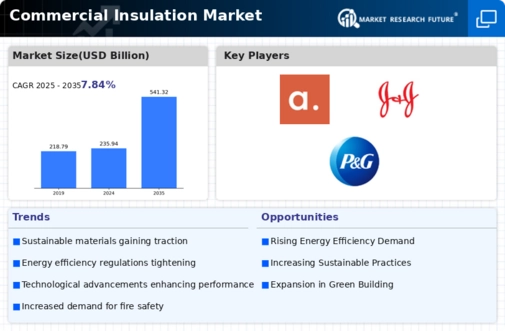-
Report Prologue
-
Scope of the Report
-
Market Definition 20
-
Scope of The Study 20
- Research
- Assumptions 20
- Limitations 20
-
Objectives 20
-
Market Structure 21
-
Research Methodology
-
Research Process 24
-
Primary Research 24
-
Secondary Research
-
Market Size Estimation 25
-
Forecast Model 26
-
Market Dynamics
-
Introduction 28
-
Drivers 29
-
Reduction in energy cost and increase in consumption of insulation material 29
-
Increasing construction of commercial building 30
-
Restraint 31
-
Less availability of skilled labor 31
-
Opportunity 32
-
High growth of opportunities in the Middle East and Asia 32
-
Trends
- Sustainability of saving energy 33
-
Market Impact Analysis
-
Supply Chain Analysis 35
- Raw
- Commercial Insulation Producers 35
- End-User 36
-
Material Suppliers 35
-
Distributors 36
-
-
Porter’s
- Threat of new entrants 36
- Bargaining power of supplier 36
- Threat of Substitute Products 37
-
Five Forces Analysis 36
-
Threat of rivalry 36
-
Bargaining power of buyer 36
-
Price Point Analysis 37
-
Investment Opportunity Analysis 38
-
Merger and Acquisition Landscape 38
-
Global Commercial
-
Insulation Market, By Product Type
-
Introduction 40
-
Wraps/Sheets
-
Coatings 43
-
Adhesives & Sealants 44
-
Global Commercial Insulation Market, By Application
-
Introduction (Institutional,
-
Hospitals, Office Buildings, Malls, Airports, Food & Beverages, Residential
-
Buildings, General Commercial, Warehouses, Lodging) 46
-
Global Commercial
-
Insulation Market, By Region
-
Introduction 50
-
North America
- U.S. 57
- Canada 61
-
Europe 66
- France 75
- Spain 79
- U.K
- Russia 87
- Italy 91
- Poland 95
-
Germany 71
-
Rest of Europe 99
-
Asia Pacific 104
- China 108
- India 116
- Australia & New Zealand
- Asean 124
- Republic of Korea 128
-
Japan 112
-
Rest of Asia Pacific 132
-
The Middle East & Africa 137
- Turkey 145
- Egypt 149
- Israel
- North Africa 157
- Rest of the Middle East &
-
G.C.C 141
-
Africa 161
-
Latin America 166
- Brazil 170
- Rest of Latin America 178
-
Argentina 174
-
Competitive Landscape
-
Introduction 183
-
Key Developments
-
of Major Market Players 183
-
Company Profiles
-
Design Polymerics 185
-
Key Developments 185
-
Products 187
-
SWOT Analysis 187
-
Overview 189
-
Strategy 189
-
Financials 191
-
Key Developments 191
-
Products 193
-
SWOT Analysis 193
-
Strategy 195
-
Company Overview 185
-
Financials
-
Products 185
-
Strategy 185
-
SWOT Analysis 185
-
Vimasco Corporation
- Company Overview 187
- Financials 187
- Strategy 187
- Key Developments 187
-
Mon Eco Industries Inc. 189
- Company
- Financials 189
- Products 189
- Key Developments 189
- SWOT Analysis
-
3M Company 191
- Company Overview 191
- Products 191
- Strategy 191
- SWOT Analysis 191
-
Henry Company
- Company Overview 193
- Financials 193
- Strategy 193
- Key Developments 193
-
Polyguard 195
- Company Overview
- Financials 195
- Products 195
- Key Developments 195
- SWOT Analysis
-
Conclusion
-
List
-
of Tables
-
WRAPS/SHEETS 37
-
COATINGS 37
-
TABLE
-
ADHESIVES & SEALANTS 38
-
GLOBAL COMMERCIAL INSULATION MARKET,
-
BY PRODUCT TYPE, 2020-2027(USD MILLION) 40
-
GLOBAL COMMERCIAL INSULATION
-
MARKET, BY PRODUCT TYPE, 2020-2027(KILOTONS) 41
-
GLOBAL COMMERCIAL
-
INSULATION MARKET FOR WRAPS/SHEETS, 2020-2027(USD MILLION) 42
-
TABLE 7
-
GLOBAL COMMERCIAL INSULATION MARKET FOR WRAPS/SHEETS, 2020-2027(KILOTONS) 42
-
TABLE
-
GLOBAL COMMERCIAL INSULATION MARKET FOR COATINGS, 2020-2027(USD MILLION) 43
-
TABLE
-
GLOBAL COMMERCIAL INSULATION MARKET FOR COATINGS, 2020-2027(KILOTONS) 43
-
TABLE
-
GLOBAL COMMERCIAL INSULATION MARKET FOR ADHESIVES & SEALANTS, 2020-2027(USD
-
MILLION) 44
-
GLOBAL COMMERCIAL INSULATION MARKET FOR ADHESIVES
-
& SEALANTS, 2020-2027(KILOTONS) 44
-
GLOBAL COMMERCIAL INSULATION
-
MARKET, BY APPLICATION, 2020-2027(USD MILLION) 47
-
GLOBAL COMMERCIAL
-
INSULATION MARKET, BY APPLICATION, 2020-2027(KILOTONS) 48
-
GLOBAL
-
COMMERCIAL INSULATION MARKET, BY REGION, 2020-2027(USD MILLION) 50
-
TABLE
-
GLOBAL COMMERCIAL INSULATION MARKET, BY REGION, 2020-2027(KILOTONS) 51
-
TABLE
-
NORTH AMERICA COMMERCIAL INSULATION MARKET, BY COUNTRY, 2020-2027(USD MILLION)
-
NORTH AMERICA COMMERCIAL INSULATION MARKET, BY COUNTRY, 2020-2027(KILOTONS)
-
NORTH AMERICA COMMERCIAL INSULATION MARKET, BY TYPE, 2020-2027(USD
-
MILLION) 53
-
NORTH AMERICA COMMERCIAL INSULATION MARKET, BY TYPE,
-
NORTH AMERICA COMMERCIAL INSULATION MARKET,
-
BY WRAPS/SHEETS, 2020-2027(USD MILLION) 54
-
NORTH AMERICA COMMERCIAL
-
INSULATION MARKET, BY WRAPS/SHEETS, 2020-2027(KILOTONS) 54
-
NORTH
-
AMERICA COMMERCIAL INSULATION MARKET, BY COATINGS, 2020-2027(USD MILLION) 54
-
TABLE
-
NORTH AMERICA COMMERCIAL INSULATION MARKET, BY COATINGS, 2020-2027(KILOTONS)
-
NORTH AMERICA COMMERCIAL INSULATION MARKET, BY ADHESIVES &
-
SEALANTS, 2020-2027(USD MILLION) 55
-
NORTH AMERICA COMMERCIAL
-
INSULATION MARKET, BY ADHESIVES & SEALANTS, 2020-2027(KILOTONS) 55
-
TABLE
-
NORTH AMERICA COMMERCIAL INSULATION MARKET, BY APPLICATION, 2020-2027(USD MILLION)
-
NORTH AMERICA COMMERCIAL INSULATION MARKET, BY APPLICATION,
-
U.S COMMERCIAL INSULATION MARKET, BY TYPE,
-
U.S COMMERCIAL INSULATION MARKET, BY
-
TYPE, 2020-2027(KILOTONS) 57
-
U.S COMMERCIAL INSULATION MARKET,
-
BY WRAPS/SHEETS, 2020-2027(USD MILLION) 57
-
U.S COMMERCIAL INSULATION
-
MARKET, BY WRAPS/SHEETS, 2020-2027(KILOTONS) 58
-
U.S COMMERCIAL
-
INSULATION MARKET, BY COATINGS, 2020-2027(USD MILLION) 58
-
U.S
-
COMMERCIAL INSULATION MARKET, BY COATINGS, 2020-2027(KILOTONS) 58
-
TABLE
-
U.S COMMERCIAL INSULATION MARKET, BY ADHESIVES & SEALANTS, 2020-2027(USD
-
MILLION) 59
-
U.S COMMERCIAL INSULATION MARKET, BY ADHESIVES &
-
SEALANTS, 2020-2027(KILOTONS) 59
-
U.S COMMERCIAL INSULATION MARKET,
-
BY APPLICATION, 2020-2027(USD MILLION) 60
-
U.S COMMERCIAL INSULATION
-
MARKET, BY APPLICATION, 2020-2027(KILOTONS) 60
-
CANADA COMMERCIAL
-
INSULATION MARKET, BY TYPE, 2020-2027(USD MILLION) 61
-
CANADA
-
COMMERCIAL INSULATION MARKET, BY TYPE, 2020-2027(KILOTONS) 61
-
TABLE 40
-
CANADA COMMERCIAL INSULATION MARKET, BY WRAPS/SHEETS, 2020-2027(USD MILLION) 61
-
TABLE
-
CANADA COMMERCIAL INSULATION MARKET, BY WRAPS/SHEETS, 2020-2027(KILOTONS) 62
-
TABLE
-
CANADA COMMERCIAL INSULATION MARKET, BY COATINGS, 2020-2027(USD MILLION) 62
-
TABLE
-
CANADA COMMERCIAL INSULATION MARKET, BY COATINGS, 2020-2027(KILOTONS) 62
-
TABLE
-
CANADA COMMERCIAL INSULATION MARKET, BY ADHESIVES & SEALANTS, 2020-2027(USD
-
MILLION) 63
-
CANADA COMMERCIAL INSULATION MARKET, BY ADHESIVES
-
& SEALANTS, 2020-2027(KILOTONS) 63
-
CANADA COMMERCIAL INSULATION
-
MARKET, BY APPLICATION, 2020-2027(USD MILLION) 64
-
CANADA COMMERCIAL
-
INSULATION MARKET, BY APPLICATION, 2020-2027(KILOTONS) 64
-
EUROPE
-
COMMERCIAL INSULATION MARKET, BY COUNTRY, 2020-2027(USD MILLION) 66
-
TABLE
-
EUROPE COMMERCIAL INSULATION MARKET, BY COUNTRY, 2020-2027(KILOTONS) 66
-
TABLE
-
EUROPE COMMERCIAL INSULATION MARKET, BY TYPE, 2020-2027(USD MILLION) 67
-
TABLE
-
EUROPE COMMERCIAL INSULATION MARKET, BY TYPE, 2020-2027(KILOTONS) 67
-
TABLE
-
EUROPE COMMERCIAL INSULATION MARKET, BY WRAPS/SHEETS, 2020-2027(USD MILLION)
-
EUROPE COMMERCIAL INSULATION MARKET, BY WRAPS/SHEETS, 2020-2027(KILOTONS)
-
EUROPE COMMERCIAL INSULATION MARKET, BY COATINGS, 2020-2027(USD
-
MILLION) 68
-
EUROPE COMMERCIAL INSULATION MARKET, BY COATINGS,
-
EUROPE COMMERCIAL INSULATION MARKET, BY
-
ADHESIVES & SEALANTS, 2020-2027(USD MILLION) 69
-
EUROPE COMMERCIAL
-
INSULATION MARKET, BY ADHESIVES & SEALANTS, 2020-2027(KILOTONS) 69
-
TABLE
-
EUROPE COMMERCIAL INSULATION MARKET, BY APPLICATION, 2020-2027(USD MILLION) 70
-
TABLE
-
EUROPE COMMERCIAL INSULATION MARKET, BY APPLICATION, 2020-2027(KILOTONS) 70
-
TABLE
-
GERMANY COMMERCIAL INSULATION MARKET, BY TYPE, 2020-2027(USD MILLION) 71
-
TABLE
-
GERMANY COMMERCIAL INSULATION MARKET, BY TYPE, 2020-2027(KILOTONS) 71
-
TABLE
-
GERMANY COMMERCIAL INSULATION MARKET, BY WRAPS/SHEETS, 2020-2027(USD MILLION)
-
GERMANY COMMERCIAL INSULATION MARKET, BY WRAPS/SHEETS, 2020-2027(KILOTONS)
-
GERMANY COMMERCIAL INSULATION MARKET, BY COATINGS, 2020-2027(USD
-
MILLION) 72
-
GERMANY COMMERCIAL INSULATION MARKET, BY COATINGS,
-
GERMANY COMMERCIAL INSULATION MARKET,
-
BY ADHESIVES & SEALANTS, 2020-2027(USD MILLION) 73
-
GERMANY
-
COMMERCIAL INSULATION MARKET, BY ADHESIVES & SEALANTS, 2020-2027(KILOTONS) 73
-
TABLE
-
GERMANY COMMERCIAL INSULATION MARKET, BY APPLICATION, 2020-2027(USD MILLION)
-
GERMANY COMMERCIAL INSULATION MARKET, BY APPLICATION, 2020-2027(KILOTONS)
-
FRANCE COMMERCIAL INSULATION MARKET, BY TYPE, 2020-2027(USD
-
MILLION) 75
-
FRANCE COMMERCIAL INSULATION MARKET, BY TYPE, 2020-2027(KILOTONS)
-
FRANCE COMMERCIAL INSULATION MARKET, BY WRAPS/SHEETS, 2020-2027(USD
-
MILLION) 75
-
FRANCE COMMERCIAL INSULATION MARKET, BY WRAPS/SHEETS,
-
FRANCE COMMERCIAL INSULATION MARKET, BY
-
COATINGS, 2020-2027(USD MILLION) 76
-
FRANCE COMMERCIAL INSULATION
-
MARKET, BY COATINGS, 2020-2027(KILOTONS) 76
-
FRANCE COMMERCIAL
-
INSULATION MARKET, BY ADHESIVES & SEALANTS, 2020-2027(USD MILLION) 77
-
TABLE
-
FRANCE COMMERCIAL INSULATION MARKET, BY ADHESIVES & SEALANTS, 2020-2027(KILOTONS)
-
FRANCE COMMERCIAL INSULATION MARKET, BY APPLICATION, 2020-2027(USD
-
MILLION) 78
-
FRANCE COMMERCIAL INSULATION MARKET, BY APPLICATION,
-
SPAIN COMMERCIAL INSULATION MARKET, BY
-
TYPE, 2020-2027(USD MILLION) 79
-
SPAIN COMMERCIAL INSULATION MARKET,
-
BY TYPE, 2020-2027(KILOTONS) 79
-
SPAIN COMMERCIAL INSULATION MARKET,
-
BY WRAPS/SHEETS, 2020-2027(USD MILLION) 79
-
SPAIN COMMERCIAL INSULATION
-
MARKET, BY WRAPS/SHEETS, 2020-2027(KILOTONS) 80
-
SPAIN COMMERCIAL
-
INSULATION MARKET, BY COATINGS, 2020-2027(USD MILLION) 80
-
SPAIN
-
COMMERCIAL INSULATION MARKET, BY COATINGS, 2020-2027(KILOTONS) 80
-
TABLE
-
SPAIN COMMERCIAL INSULATION MARKET, BY ADHESIVES & SEALANTS, 2020-2027(USD
-
MILLION) 81
-
SPAIN COMMERCIAL INSULATION MARKET, BY ADHESIVES
-
& SEALANTS, 2020-2027(KILOTONS) 81
-
SPAIN COMMERCIAL INSULATION
-
MARKET, BY APPLICATION, 2020-2027(USD MILLION) 82
-
SPAIN COMMERCIAL
-
INSULATION MARKET, BY APPLICATION, 2020-2027(KILOTONS) 82
-
U.K
-
COMMERCIAL INSULATION MARKET, BY TYPE, 2020-2027(USD MILLION) 83
-
TABLE
-
U.K COMMERCIAL INSULATION MARKET, BY TYPE, 2020-2027(KILOTONS) 83
-
TABLE
-
U.K COMMERCIAL INSULATION MARKET, BY WRAPS/SHEETS, 2020-2027(USD MILLION) 83
-
TABLE
-
U.K COMMERCIAL INSULATION MARKET, BY WRAPS/SHEETS, 2020-2027(KILOTONS) 84
-
TABLE
-
U.K COMMERCIAL INSULATION MARKET, BY COATINGS, 2020-2027(USD MILLION) 84
-
TABLE
-
U.K COMMERCIAL INSULATION MARKET, BY COATINGS, 2020-2027(KILOTONS) 84
-
TABLE
-
U.K COMMERCIAL INSULATION MARKET, BY ADHESIVES & SEALANTS, 2020-2027(USD
-
MILLION) 85
-
U.K COMMERCIAL INSULATION MARKET, BY ADHESIVES &
-
SEALANTS, 2020-2027(KILOTONS) 85
-
U.K COMMERCIAL INSULATION MARKET,
-
BY APPLICATION, 2020-2027(USD MILLION) 86
-
U.K COMMERCIAL INSULATION
-
MARKET, BY APPLICATION, 2020-2027(KILOTONS) 86
-
RUSSIA COMMERCIAL
-
INSULATION MARKET, BY TYPE, 2020-2027(USD MILLION) 87
-
RUSSIA
-
COMMERCIAL INSULATION MARKET, BY TYPE, 2020-2027(KILOTONS) 87
-
TABLE 102
-
RUSSIA COMMERCIAL INSULATION MARKET, BY WRAPS/SHEETS, 2020-2027(USD MILLION) 87
-
TABLE
-
RUSSIA COMMERCIAL INSULATION MARKET, BY WRAPS/SHEETS, 2020-2027(KILOTONS) 88
-
TABLE
-
RUSSIA COMMERCIAL INSULATION MARKET, BY COATINGS, 2020-2027(USD MILLION) 88
-
TABLE
-
RUSSIA COMMERCIAL INSULATION MARKET, BY COATINGS, 2020-2027(KILOTONS) 88
-
TABLE
-
RUSSIA COMMERCIAL INSULATION MARKET, BY ADHESIVES & SEALANTS, 2020-2027(USD
-
MILLION) 89
-
RUSSIA COMMERCIAL INSULATION MARKET, BY ADHESIVES
-
& SEALANTS, 2020-2027(KILOTONS) 89
-
RUSSIA COMMERCIAL INSULATION
-
MARKET, BY APPLICATION, 2020-2027(USD MILLION) 90
-
RUSSIA COMMERCIAL
-
INSULATION MARKET, BY APPLICATION, 2020-2027(KILOTONS) 90
-
ITALY
-
COMMERCIAL INSULATION MARKET, BY TYPE, 2020-2027(USD MILLION) 91
-
TABLE
-
ITALY COMMERCIAL INSULATION MARKET, BY TYPE, 2020-2027(KILOTONS) 91
-
TABLE
-
ITALY COMMERCIAL INSULATION MARKET, BY WRAPS/SHEETS, 2020-2027(USD MILLION)
-
ITALY COMMERCIAL INSULATION MARKET, BY WRAPS/SHEETS, 2020-2027(KILOTONS)
-
ITALY COMMERCIAL INSULATION MARKET, BY COATINGS, 2020-2027(USD
-
MILLION) 92
-
ITALY COMMERCIAL INSULATION MARKET, BY COATINGS,
-
ITALY COMMERCIAL INSULATION MARKET, BY
-
ADHESIVES & SEALANTS, 2020-2027(USD MILLION) 93
-
ITALY COMMERCIAL
-
INSULATION MARKET, BY ADHESIVES & SEALANTS, 2020-2027(KILOTONS) 93
-
TABLE
-
ITALY COMMERCIAL INSULATION MARKET, BY APPLICATION, 2020-2027(USD MILLION) 94
-
TABLE
-
ITALY COMMERCIAL INSULATION MARKET, BY APPLICATION, 2020-2027(KILOTONS) 94
-
TABLE
-
POLAND COMMERCIAL INSULATION MARKET, BY TYPE, 2020-2027(USD MILLION) 95
-
TABLE
-
POLAND COMMERCIAL INSULATION MARKET, BY TYPE, 2020-2027(KILOTONS) 95
-
TABLE
-
POLAND COMMERCIAL INSULATION MARKET, BY WRAPS/SHEETS, 2020-2027(USD MILLION)
-
POLAND COMMERCIAL INSULATION MARKET, BY WRAPS/SHEETS, 2020-2027(KILOTONS)
-
POLAND COMMERCIAL INSULATION MARKET, BY COATINGS, 2020-2027(USD
-
MILLION) 96
-
POLAND COMMERCIAL INSULATION MARKET, BY COATINGS,
-
POLAND COMMERCIAL INSULATION MARKET,
-
BY ADHESIVES & SEALANTS, 2020-2027(USD MILLION) 97
-
POLAND
-
COMMERCIAL INSULATION MARKET, BY ADHESIVES & SEALANTS, 2020-2027(KILOTONS) 97
-
TABLE
-
POLAND COMMERCIAL INSULATION MARKET, BY APPLICATION, 2020-2027(USD MILLION)
-
POLAND COMMERCIAL INSULATION MARKET, BY APPLICATION, 2020-2027(KILOTONS)
-
REST OF EUROPE COMMERCIAL INSULATION MARKET, BY TYPE, 2020-2027(USD
-
MILLION) 99
-
REST OF EUROPE COMMERCIAL INSULATION MARKET, BY
-
TYPE, 2020-2027(KILOTONS) 99
-
REST OF EUROPE COMMERCIAL INSULATION
-
MARKET, BY WRAPS/SHEETS, 2020-2027(USD MILLION) 99
-
REST OF EUROPE
-
COMMERCIAL INSULATION MARKET, BY WRAPS/SHEETS, 2020-2027(KILOTONS) 100
-
TABLE
-
REST OF EUROPE COMMERCIAL INSULATION MARKET, BY COATINGS, 2020-2027(USD MILLION)
-
REST OF EUROPE COMMERCIAL INSULATION MARKET, BY COATINGS,
-
REST OF EUROPE COMMERCIAL INSULATION
-
MARKET, BY ADHESIVES & SEALANTS, 2020-2027(USD MILLION) 101
-
TABLE
-
REST OF EUROPE COMMERCIAL INSULATION MARKET, BY ADHESIVES & SEALANTS, 2020-2027(KILOTONS)
-
REST OF EUROPE COMMERCIAL INSULATION MARKET, BY APPLICATION,
-
REST OF EUROPE COMMERCIAL INSULATION
-
MARKET, BY APPLICATION, 2020-2027(KILOTONS) 102
-
ASIA-PACIFIC
-
COMMERCIAL INSULATION MARKET, BY COUNTRY, 2020-2027(USD MILLION) 104
-
TABLE
-
ASIA-PACIFIC COMMERCIAL INSULATION MARKET, BY COUNTRY, 2020-2027(KILOTONS) 104
-
TABLE
-
ASIA-PACIFIC COMMERCIAL INSULATION MARKET, BY TYPE, 2020-2027(USD MILLION) 104
-
TABLE
-
ASIA-PACIFIC COMMERCIAL INSULATION MARKET, BY TYPE, 2020-2027(KILOTONS) 105
-
TABLE
-
ASIA-PACIFIC COMMERCIAL INSULATION MARKET, BY WRAPS/SHEETS, 2020-2027(USD MILLION)
-
ASIA-PACIFIC COMMERCIAL INSULATION MARKET, BY WRAPS/SHEETS,
-
ASIA-PACIFIC COMMERCIAL INSULATION MARKET,
-
BY COATINGS, 2020-2027(USD MILLION) 106
-
ASIA-PACIFIC COMMERCIAL
-
INSULATION MARKET, BY COATINGS, 2020-2027(KILOTONS) 106
-
ASIA-PACIFIC
-
COMMERCIAL INSULATION MARKET, BY ADHESIVES & SEALANTS, 2020-2027(USD MILLION)
-
ASIA-PACIFIC COMMERCIAL INSULATION MARKET, BY ADHESIVES
-
& SEALANTS, 2020-2027(KILOTONS) 107
-
ASIA-PACIFIC COMMERCIAL
-
INSULATION MARKET, BY APPLICATION, 2020-2027(USD MILLION) 107
-
TABLE 151
-
ASIA-PACIFIC COMMERCIAL INSULATION MARKET, BY APPLICATION, 2020-2027(KILOTONS) 108
-
TABLE
-
CHINA COMMERCIAL INSULATION MARKET, BY TYPE, 2020-2027(USD MILLION) 108
-
TABLE
-
CHINA COMMERCIAL INSULATION MARKET, BY TYPE, 2020-2027(KILOTONS) 108
-
TABLE
-
CHINA COMMERCIAL INSULATION MARKET, BY WRAPS/SHEETS, 2020-2027(USD MILLION)
-
CHINA COMMERCIAL INSULATION MARKET, BY WRAPS/SHEETS, 2020-2027(KILOTONS)
-
CHINA COMMERCIAL INSULATION MARKET, BY COATINGS, 2020-2027(USD
-
MILLION) 109
-
CHINA COMMERCIAL INSULATION MARKET, BY COATINGS,
-
CHINA COMMERCIAL INSULATION MARKET,
-
BY ADHESIVES & SEALANTS, 2020-2027(USD MILLION) 110
-
CHINA
-
COMMERCIAL INSULATION MARKET, BY ADHESIVES & SEALANTS, 2020-2027(KILOTONS) 110
-
TABLE
-
CHINA COMMERCIAL INSULATION MARKET, BY APPLICATION, 2020-2027(USD MILLION) 111
-
TABLE
-
CHINA COMMERCIAL INSULATION MARKET, BY APPLICATION, 2020-2027(KILOTONS) 111
-
TABLE
-
JAPAN COMMERCIAL INSULATION MARKET, BY TYPE, 2020-2027(USD MILLION) 112
-
TABLE
-
JAPAN COMMERCIAL INSULATION MARKET, BY TYPE, 2020-2027(KILOTONS) 112
-
TABLE
-
JAPAN COMMERCIAL INSULATION MARKET, BY WRAPS/SHEETS, 2020-2027(USD MILLION)
-
JAPAN COMMERCIAL INSULATION MARKET, BY WRAPS/SHEETS, 2020-2027(KILOTONS)
-
JAPAN COMMERCIAL INSULATION MARKET, BY COATINGS, 2020-2027(USD
-
MILLION) 113
-
JAPAN COMMERCIAL INSULATION MARKET, BY COATINGS,
-
JAPAN COMMERCIAL INSULATION MARKET,
-
BY ADHESIVES & SEALANTS, 2020-2027(USD MILLION) 114
-
JAPAN
-
COMMERCIAL INSULATION MARKET, BY ADHESIVES & SEALANTS, 2020-2027(KILOTONS) 114
-
TABLE
-
JAPAN COMMERCIAL INSULATION MARKET, BY APPLICATION, 2020-2027(USD MILLION) 115
-
TABLE
-
JAPAN COMMERCIAL INSULATION MARKET, BY APPLICATION, 2020-2027(KILOTONS) 115
-
TABLE
-
INDIA COMMERCIAL INSULATION MARKET, BY TYPE, 2020-2027(USD MILLION) 116
-
TABLE
-
INDIA COMMERCIAL INSULATION MARKET, BY TYPE, 2020-2027(KILOTONS) 116
-
TABLE
-
INDIA COMMERCIAL INSULATION MARKET, BY WRAPS/SHEETS, 2020-2027(USD MILLION)
-
INDIA COMMERCIAL INSULATION MARKET, BY WRAPS/SHEETS, 2020-2027(KILOTONS)
-
INDIA COMMERCIAL INSULATION MARKET, BY COATINGS, 2020-2027(USD
-
MILLION) 117
-
INDIA COMMERCIAL INSULATION MARKET, BY COATINGS,
-
INDIA COMMERCIAL INSULATION MARKET,
-
BY ADHESIVES & SEALANTS, 2020-2027(USD MILLION) 118
-
INDIA
-
COMMERCIAL INSULATION MARKET, BY ADHESIVES & SEALANTS, 2020-2027(KILOTONS) 118
-
TABLE
-
INDIA COMMERCIAL INSULATION MARKET, BY APPLICATION, 2020-2027(USD MILLION) 119
-
TABLE
-
INDIA COMMERCIAL INSULATION MARKET, BY APPLICATION, 2020-2027(KILOTONS) 119
-
TABLE
-
AUSTRALIA & NEW ZEALAND COMMERCIAL INSULATION MARKET, BY TYPE, 2020-2027(USD
-
MILLION) 120
-
AUSTRALIA & NEW ZEALAND COMMERCIAL INSULATION
-
MARKET, BY TYPE, 2020-2027(KILOTONS) 120
-
AUSTRALIA & NEW
-
ZEALAND COMMERCIAL INSULATION MARKET, BY WRAPS/SHEETS, 2020-2027(USD MILLION) 120
-
TABLE
-
AUSTRALIA & NEW ZEALAND COMMERCIAL INSULATION MARKET, BY WRAPS/SHEETS, 2020-2027(KILOTONS)
-
AUSTRALIA & NEW ZEALAND COMMERCIAL INSULATION MARKET,
-
BY COATINGS, 2020-2027(USD MILLION) 121
-
AUSTRALIA & NEW
-
ZEALAND COMMERCIAL INSULATION MARKET, BY COATINGS, 2020-2027(KILOTONS) 121
-
TABLE
-
AUSTRALIA & NEW ZEALAND COMMERCIAL INSULATION MARKET, BY ADHESIVES &
-
SEALANTS, 2020-2027(USD MILLION) 122
-
AUSTRALIA & NEW ZEALAND
-
COMMERCIAL INSULATION MARKET, BY ADHESIVES & SEALANTS, 2020-2027(KILOTONS) 122
-
TABLE
-
AUSTRALIA & NEW ZEALAND COMMERCIAL INSULATION MARKET, BY APPLICATION, 2020-2027(USD
-
MILLION) 123
-
AUSTRALIA & NEW ZEALAND COMMERCIAL INSULATION
-
MARKET, BY APPLICATION, 2020-2027(KILOTONS) 123
-
ASEAN COMMERCIAL
-
INSULATION MARKET, BY TYPE, 2020-2027(USD MILLION) 124
-
ASEAN
-
COMMERCIAL INSULATION MARKET, BY TYPE, 2020-2027(KILOTONS) 124
-
TABLE 194
-
ASEAN COMMERCIAL INSULATION MARKET, BY WRAPS/SHEETS, 2020-2027(USD MILLION) 124
-
TABLE
-
ASEAN COMMERCIAL INSULATION MARKET, BY WRAPS/SHEETS, 2020-2027(KILOTONS) 125
-
TABLE
-
ASEAN COMMERCIAL INSULATION MARKET, BY COATINGS, 2020-2027(USD MILLION) 125
-
TABLE
-
ASEAN COMMERCIAL INSULATION MARKET, BY COATINGS, 2020-2027(KILOTONS) 125
-
TABLE
-
ASEAN COMMERCIAL INSULATION MARKET, BY ADHESIVES & SEALANTS, 2020-2027(USD
-
MILLION) 126
-
ASEAN COMMERCIAL INSULATION MARKET, BY ADHESIVES
-
& SEALANTS, 2020-2027(KILOTONS) 126
-
ASEAN COMMERCIAL INSULATION
-
MARKET, BY APPLICATION, 2020-2027(USD MILLION) 127
-
ASEAN COMMERCIAL
-
INSULATION MARKET, BY APPLICATION, 2020-2027(KILOTONS) 127
-
REPUBLIC
-
OF KOREA COMMERCIAL INSULATION MARKET, BY TYPE, 2020-2027(USD MILLION) 128
-
TABLE
-
REPUBLIC OF KOREA COMMERCIAL INSULATION MARKET, BY TYPE, 2020-2027(KILOTONS)
-
REPUBLIC OF KOREA COMMERCIAL INSULATION MARKET, BY WRAPS/SHEETS,
-
REPUBLIC OF KOREA COMMERCIAL INSULATION
-
MARKET, BY WRAPS/SHEETS, 2020-2027(KILOTONS) 129
-
REPUBLIC OF
-
KOREA COMMERCIAL INSULATION MARKET, BY COATINGS, 2020-2027(USD MILLION) 129
-
TABLE
-
REPUBLIC OF KOREA COMMERCIAL INSULATION MARKET, BY COATINGS, 2020-2027(KILOTONS)
-
REPUBLIC OF KOREA COMMERCIAL INSULATION MARKET, BY ADHESIVES
-
& SEALANTS, 2020-2027(USD MILLION) 130
-
REPUBLIC OF KOREA
-
COMMERCIAL INSULATION MARKET, BY ADHESIVES & SEALANTS, 2020-2027(KILOTONS) 130
-
TABLE
-
REPUBLIC OF KOREA COMMERCIAL INSULATION MARKET, BY APPLICATION, 2020-2027(USD
-
MILLION) 131
-
REPUBLIC OF KOREA COMMERCIAL INSULATION MARKET,
-
BY APPLICATION, 2020-2027(KILOTONS) 131
-
REST OF ASIA-PACIFIC
-
COMMERCIAL INSULATION MARKET, BY TYPE, 2020-2027(USD MILLION) 132
-
TABLE
-
REST OF ASIA-PACIFIC COMMERCIAL INSULATION MARKET, BY TYPE, 2020-2027(KILOTONS)
-
REST OF ASIA-PACIFIC COMMERCIAL INSULATION MARKET, BY WRAPS/SHEETS,
-
REST OF ASIA-PACIFIC COMMERCIAL INSULATION
-
MARKET, BY WRAPS/SHEETS, 2020-2027(KILOTONS) 133
-
REST OF ASIA-PACIFIC
-
COMMERCIAL INSULATION MARKET, BY COATINGS, 2020-2027(USD MILLION) 133
-
TABLE
-
REST OF ASIA-PACIFIC COMMERCIAL INSULATION MARKET, BY COATINGS, 2020-2027(KILOTONS)
-
REST OF ASIA-PACIFIC COMMERCIAL INSULATION MARKET, BY ADHESIVES
-
& SEALANTS, 2020-2027(USD MILLION) 134
-
REST OF ASIA-PACIFIC
-
COMMERCIAL INSULATION MARKET, BY ADHESIVES & SEALANTS, 2020-2027(KILOTONS) 134
-
TABLE
-
REST OF ASIA-PACIFIC COMMERCIAL INSULATION MARKET, BY APPLICATION, 2020-2027(USD
-
MILLION) 135
-
REST OF ASIA-PACIFIC COMMERCIAL INSULATION MARKET,
-
BY APPLICATION, 2020-2027(KILOTONS) 135
-
MIDDLE EAST & AFRICA
-
COMMERCIAL INSULATION MARKET, BY COUNTRY, 2020-2027(USD MILLION) 137
-
TABLE
-
MIDDLE EAST & AFRICA COMMERCIAL INSULATION MARKET, BY COUNTRY, 2020-2027(KILOTONS)
-
MIDDLE EAST & AFRICA COMMERCIAL INSULATION MARKET, BY
-
TYPE, 2020-2027(USD MILLION) 137
-
MIDDLE EAST & AFRICA COMMERCIAL
-
INSULATION MARKET, BY TYPE, 2020-2027(KILOTONS) 138
-
MIDDLE EAST
-
& AFRICA COMMERCIAL INSULATION MARKET, BY WRAPS/SHEETS, 2020-2027(USD MILLION)
-
MIDDLE EAST & AFRICA COMMERCIAL INSULATION MARKET, BY
-
WRAPS/SHEETS, 2020-2027(KILOTONS) 138
-
MIDDLE EAST & AFRICA
-
COMMERCIAL INSULATION MARKET, BY COATINGS, 2020-2027(USD MILLION) 139
-
TABLE
-
MIDDLE EAST & AFRICA COMMERCIAL INSULATION MARKET, BY COATINGS, 2020-2027(KILOTONS)
-
MIDDLE EAST & AFRICA COMMERCIAL INSULATION MARKET, BY
-
ADHESIVES & SEALANTS, 2020-2027(USD MILLION) 139
-
MIDDLE
-
EAST & AFRICA COMMERCIAL INSULATION MARKET, BY ADHESIVES & SEALANTS, 2020-2027(KILOTONS)
-
MIDDLE EAST & AFRICA COMMERCIAL INSULATION MARKET, BY
-
APPLICATION, 2020-2027(USD MILLION) 140
-
MIDDLE EAST & AFRICA
-
COMMERCIAL INSULATION MARKET, BY APPLICATION, 2020-2027(KILOTONS) 141
-
TABLE
-
G.C.C COMMERCIAL INSULATION MARKET, BY TYPE, 2020-2027(USD MILLION) 141
-
TABLE
-
G.C.C COMMERCIAL INSULATION MARKET, BY TYPE, 2020-2027(KILOTONS) 141
-
TABLE
-
G.C.C COMMERCIAL INSULATION MARKET, BY WRAPS/SHEETS, 2020-2027(USD MILLION)
-
G.C.C COMMERCIAL INSULATION MARKET, BY WRAPS/SHEETS, 2020-2027(KILOTONS)
-
G.C.C COMMERCIAL INSULATION MARKET, BY COATINGS, 2020-2027(USD
-
MILLION) 142
-
G.C.C COMMERCIAL INSULATION MARKET, BY COATINGS,
-
G.C.C COMMERCIAL INSULATION MARKET,
-
BY ADHESIVES & SEALANTS, 2020-2027(USD MILLION) 143
-
G.C.C
-
COMMERCIAL INSULATION MARKET, BY ADHESIVES & SEALANTS, 2020-2027(KILOTONS) 143
-
TABLE
-
G.C.C COMMERCIAL INSULATION MARKET, BY APPLICATION, 2020-2027(USD MILLION) 144
-
TABLE
-
G.C.C COMMERCIAL INSULATION MARKET, BY APPLICATION, 2020-2027(KILOTONS) 144
-
TABLE
-
TURKEY COMMERCIAL INSULATION MARKET, BY TYPE, 2020-2027(USD MILLION) 145
-
TABLE
-
TURKEY COMMERCIAL INSULATION MARKET, BY TYPE, 2020-2027(KILOTONS) 145
-
TABLE
-
TURKEY COMMERCIAL INSULATION MARKET, BY WRAPS/SHEETS, 2020-2027(USD MILLION)
-
TURKEY COMMERCIAL INSULATION MARKET, BY WRAPS/SHEETS, 2020-2027(KILOTONS)
-
TURKEY COMMERCIAL INSULATION MARKET, BY COATINGS, 2020-2027(USD
-
MILLION) 146
-
TURKEY COMMERCIAL INSULATION MARKET, BY COATINGS,
-
TURKEY COMMERCIAL INSULATION MARKET,
-
BY ADHESIVES & SEALANTS, 2020-2027(USD MILLION) 147
-
TURKEY
-
COMMERCIAL INSULATION MARKET, BY ADHESIVES & SEALANTS, 2020-2027(KILOTONS) 147
-
TABLE
-
TURKEY COMMERCIAL INSULATION MARKET, BY APPLICATION, 2020-2027(USD MILLION)
-
TURKEY COMMERCIAL INSULATION MARKET, BY APPLICATION, 2020-2027(KILOTONS)
-
EGYPT COMMERCIAL INSULATION MARKET, BY TYPE, 2020-2027(USD
-
MILLION) 149
-
EGYPT COMMERCIAL INSULATION MARKET, BY TYPE, 2020-2027(KILOTONS)
-
EGYPT COMMERCIAL INSULATION MARKET, BY WRAPS/SHEETS, 2020-2027(USD
-
MILLION) 149
-
EGYPT COMMERCIAL INSULATION MARKET, BY WRAPS/SHEETS,
-
EGYPT COMMERCIAL INSULATION MARKET,
-
BY COATINGS, 2020-2027(USD MILLION) 150
-
EGYPT COMMERCIAL INSULATION
-
MARKET, BY COATINGS, 2020-2027(KILOTONS) 150
-
EGYPT COMMERCIAL
-
INSULATION MARKET, BY ADHESIVES & SEALANTS, 2020-2027(USD MILLION) 151
-
TABLE
-
EGYPT COMMERCIAL INSULATION MARKET, BY ADHESIVES & SEALANTS, 2020-2027(KILOTONS)
-
EGYPT COMMERCIAL INSULATION MARKET, BY APPLICATION, 2020-2027(USD
-
MILLION) 152
-
EGYPT COMMERCIAL INSULATION MARKET, BY APPLICATION,
-
ISRAEL COMMERCIAL INSULATION MARKET,
-
BY TYPE, 2020-2027(USD MILLION) 153
-
ISRAEL COMMERCIAL INSULATION
-
MARKET, BY TYPE, 2020-2027(KILOTONS) 153
-
ISRAEL COMMERCIAL INSULATION
-
MARKET, BY WRAPS/SHEETS, 2020-2027(USD MILLION) 153
-
ISRAEL COMMERCIAL
-
INSULATION MARKET, BY WRAPS/SHEETS, 2020-2027(KILOTONS) 154
-
TABLE 268
-
ISRAEL COMMERCIAL INSULATION MARKET, BY COATINGS, 2020-2027(USD MILLION) 154
-
TABLE
-
ISRAEL COMMERCIAL INSULATION MARKET, BY COATINGS, 2020-2027(KILOTONS) 154
-
TABLE
-
ISRAEL COMMERCIAL INSULATION MARKET, BY ADHESIVES & SEALANTS, 2020-2027(USD
-
MILLION) 155
-
ISRAEL COMMERCIAL INSULATION MARKET, BY ADHESIVES
-
& SEALANTS, 2020-2027(KILOTONS) 155
-
ISRAEL COMMERCIAL INSULATION
-
MARKET, BY APPLICATION, 2020-2027(USD MILLION) 156
-
ISRAEL COMMERCIAL
-
INSULATION MARKET, BY APPLICATION, 2020-2027(KILOTONS) 156
-
NORTH
-
AFRICA COMMERCIAL INSULATION MARKET, BY TYPE, 2020-2027(USD MILLION) 157
-
TABLE
-
NORTH AFRICA COMMERCIAL INSULATION MARKET, BY TYPE, 2020-2027(KILOTONS) 157
-
TABLE
-
NORTH AFRICA COMMERCIAL INSULATION MARKET, BY WRAPS/SHEETS, 2020-2027(USD MILLION)
-
NORTH AFRICA COMMERCIAL INSULATION MARKET, BY WRAPS/SHEETS,
-
NORTH AFRICA COMMERCIAL INSULATION MARKET,
-
BY COATINGS, 2020-2027(USD MILLION) 158
-
NORTH AFRICA COMMERCIAL
-
INSULATION MARKET, BY COATINGS, 2020-2027(KILOTONS) 158
-
NORTH
-
AFRICA COMMERCIAL INSULATION MARKET, BY ADHESIVES & SEALANTS, 2020-2027(USD
-
MILLION) 159
-
NORTH AFRICA COMMERCIAL INSULATION MARKET, BY ADHESIVES
-
& SEALANTS, 2020-2027(KILOTONS) 159
-
NORTH AFRICA COMMERCIAL
-
INSULATION MARKET, BY APPLICATION, 2020-2027(USD MILLION) 160
-
TABLE 283
-
NORTH AFRICA COMMERCIAL INSULATION MARKET, BY APPLICATION, 2020-2027(KILOTONS) 160
-
TABLE
-
REST OF MIDDLE EAST & AFRICA COMMERCIAL INSULATION MARKET, BY TYPE, 2020-2027(USD
-
MILLION) 161
-
REST OF MIDDLE EAST & AFRICA COMMERCIAL INSULATION
-
MARKET, BY TYPE, 2020-2027(KILOTONS) 161
-
REST OF MIDDLE EAST
-
& AFRICA COMMERCIAL INSULATION MARKET, BY WRAPS/SHEETS, 2020-2027(USD MILLION)
-
REST OF MIDDLE EAST & AFRICA COMMERCIAL INSULATION MARKET,
-
BY WRAPS/SHEETS, 2020-2027(KILOTONS) 162
-
REST OF MIDDLE EAST
-
& AFRICA COMMERCIAL INSULATION MARKET, BY COATINGS, 2020-2027(USD MILLION) 162
-
TABLE
-
REST OF MIDDLE EAST & AFRICA COMMERCIAL INSULATION MARKET, BY COATINGS,
-
REST OF MIDDLE EAST & AFRICA COMMERCIAL
-
INSULATION MARKET, BY ADHESIVES & SEALANTS, 2020-2027(USD MILLION) 163
-
TABLE
-
REST OF MIDDLE EAST & AFRICA COMMERCIAL INSULATION MARKET, BY ADHESIVES
-
& SEALANTS, 2020-2027(KILOTONS) 163
-
REST OF MIDDLE EAST
-
& AFRICA COMMERCIAL INSULATION MARKET, BY APPLICATION, 2020-2027(USD MILLION)
-
REST OF MIDDLE EAST & AFRICA COMMERCIAL INSULATION MARKET,
-
BY APPLICATION, 2020-2027(KILOTONS) 164
-
LATIN AMERICA COMMERCIAL
-
INSULATION MARKET, BY COUNTRY, 2020-2027(USD MILLION) 166
-
LATIN
-
AMERICA COMMERCIAL INSULATION MARKET, BY COUNTRY, 2020-2027(KILOTONS) 166
-
TABLE
-
LATIN AMERICA COMMERCIAL INSULATION MARKET, BY TYPE, 2020-2027(USD MILLION)
-
LATIN AMERICA COMMERCIAL INSULATION MARKET, BY TYPE, 2020-2027(KILOTONS)
-
LATIN AMERICA COMMERCIAL INSULATION MARKET, BY WRAPS/SHEETS,
-
LATIN AMERICA COMMERCIAL INSULATION
-
MARKET, BY WRAPS/SHEETS, 2020-2027(KILOTONS) 167
-
LATIN AMERICA
-
COMMERCIAL INSULATION MARKET, BY COATINGS, 2020-2027(USD MILLION) 167
-
TABLE
-
LATIN AMERICA COMMERCIAL INSULATION MARKET, BY COATINGS, 2020-2027(KILOTONS)
-
LATIN AMERICA COMMERCIAL INSULATION MARKET, BY ADHESIVES
-
& SEALANTS, 2020-2027(USD MILLION) 168
-
LATIN AMERICA COMMERCIAL
-
INSULATION MARKET, BY ADHESIVES & SEALANTS, 2020-2027(KILOTONS) 168
-
TABLE
-
LATIN AMERICA COMMERCIAL INSULATION MARKET, BY APPLICATION, 2020-2027(USD MILLION)
-
LATIN AMERICA COMMERCIAL INSULATION MARKET, BY APPLICATION,
-
BRAZIL COMMERCIAL INSULATION MARKET,
-
BY TYPE, 2020-2027(USD MILLION) 170
-
BRAZIL COMMERCIAL INSULATION
-
MARKET, BY TYPE, 2020-2027(KILOTONS) 170
-
BRAZIL COMMERCIAL INSULATION
-
MARKET, BY WRAPS/SHEETS, 2020-2027(USD MILLION) 170
-
BRAZIL COMMERCIAL
-
INSULATION MARKET, BY WRAPS/SHEETS, 2020-2027(KILOTONS) 171
-
TABLE 310
-
BRAZIL COMMERCIAL INSULATION MARKET, BY COATINGS, 2020-2027(USD MILLION) 171
-
TABLE
-
BRAZIL COMMERCIAL INSULATION MARKET, BY COATINGS, 2020-2027(KILOTONS) 171
-
TABLE
-
BRAZIL COMMERCIAL INSULATION MARKET, BY ADHESIVES & SEALANTS, 2020-2027(USD
-
MILLION) 172
-
BRAZIL COMMERCIAL INSULATION MARKET, BY ADHESIVES
-
& SEALANTS, 2020-2027(KILOTONS) 172
-
BRAZIL COMMERCIAL INSULATION
-
MARKET, BY APPLICATION, 2020-2027(USD MILLION) 173
-
BRAZIL COMMERCIAL
-
INSULATION MARKET, BY APPLICATION, 2020-2027(KILOTONS) 173
-
ARGENTINA
-
COMMERCIAL INSULATION MARKET, BY TYPE, 2020-2027(USD MILLION) 174
-
TABLE
-
ARGENTINA COMMERCIAL INSULATION MARKET, BY TYPE, 2020-2027(KILOTONS) 174
-
TABLE
-
ARGENTINA COMMERCIAL INSULATION MARKET, BY WRAPS/SHEETS, 2020-2027(USD MILLION)
-
ARGENTINA COMMERCIAL INSULATION MARKET, BY WRAPS/SHEETS,
-
ARGENTINA COMMERCIAL INSULATION MARKET,
-
BY COATINGS, 2020-2027(USD MILLION) 175
-
ARGENTINA COMMERCIAL
-
INSULATION MARKET, BY COATINGS, 2020-2027(KILOTONS) 175
-
ARGENTINA
-
COMMERCIAL INSULATION MARKET, BY ADHESIVES & SEALANTS, 2020-2027(USD MILLION)
-
ARGENTINA COMMERCIAL INSULATION MARKET, BY ADHESIVES &
-
SEALANTS, 2020-2027(KILOTONS) 176
-
ARGENTINA COMMERCIAL INSULATION
-
MARKET, BY APPLICATION, 2020-2027(USD MILLION) 177
-
ARGENTINA
-
COMMERCIAL INSULATION MARKET, BY APPLICATION, 2020-2027(KILOTONS) 177
-
TABLE
-
REST OF LATIN AMERICA COMMERCIAL INSULATION MARKET, BY TYPE, 2020-2027(USD MILLION)
-
REST OF LATIN AMERICA COMMERCIAL INSULATION MARKET, BY TYPE,
-
REST OF LATIN AMERICA COMMERCIAL INSULATION
-
MARKET, BY WRAPS/SHEETS, 2020-2027(USD MILLION) 178
-
REST OF
-
LATIN AMERICA COMMERCIAL INSULATION MARKET, BY WRAPS/SHEETS, 2020-2027(KILOTONS)
-
REST OF LATIN AMERICA COMMERCIAL INSULATION MARKET, BY COATINGS,
-
REST OF LATIN AMERICA COMMERCIAL
-
INSULATION MARKET, BY COATINGS, 2020-2027(KILOTONS) 179
-
REST
-
OF LATIN AMERICA COMMERCIAL INSULATION MARKET, BY ADHESIVES & SEALANTS, 2020-2027(USD
-
MILLION) 180
-
REST OF LATIN AMERICA COMMERCIAL INSULATION MARKET,
-
BY ADHESIVES & SEALANTS, 2020-2027(KILOTONS) 180
-
REST OF
-
LATIN AMERICA COMMERCIAL INSULATION MARKET, BY APPLICATION, 2020-2027(USD MILLION)
-
REST OF LATIN AMERICA COMMERCIAL INSULATION MARKET, BY APPLICATION,
-
MERGERS & ACQUISITIONS 183
-
-
List of Figures
-
TOP DOWN & BOTTOMUP APPROACH 25
-
FIGURE
-
FORECAST MODEL 26
-
DRIVERS, RESTRAINT, OPPORTUNITY, AND TREND
-
OF GLOBAL COMMERCIAL INSULATION MARKET 28
-
SUPPLY CHAIN ANALYSIS
-
GLOBAL COMMERCIAL INSULATION MARKET, BY PRODUCT TYPE, 2020-2027(USD
-
MILLION) 40
-
GLOBAL COMMERCIAL INSULATION MARKET, BY PRODUCT TYPE,
-
GLOBAL COMMERCIAL INSULATION MARKET, BY
-
APPLICATION, 2020-2027(USD MILLION) 46
-
GLOBAL COMMERCIAL INSULATION
-
MARKET, BY APPLICATION, 2020-2027(KILOTONS) 47
-
GLOBAL COMMERCIAL
-
INSULATION MARKET, BY REGION, 2020-2027(USD MILLION) 50
-
GLOBAL
-
COMMERCIAL INSULATION MARKET, BY REGION, 2020-2027(KILOTONS) 51
-
FIGURE
-
DESIGN POLYMERICS: SWOT ANALYSIS 186
-
VIMASCO CORPORATION:
-
SWOT ANALYSIS 188
-
MON ECO INDUSTRIES INC.: SWOT ANALYSIS 190
-
FIGURE
-
3M COMPANY: SWOT ANALYSIS 192
-
HENRY COMPANY: SWOT ANALYSIS
-
POLYGUARD: SWOT ANALYSIS 196














Leave a Comment